In ancient silk mythology, it has been written that the invention of silk had come from an ancient Kohen (Cohen, Koan or  Coan) woman from the island of Kos (Cos, Coos, Zia or Dia) called Pamphila, who was the daughter of Plateus. She had invented the means of producing and weaving the local silk, which at the time became one of the great luxuries lasting many centuries.
Coan) woman from the island of Kos (Cos, Coos, Zia or Dia) called Pamphila, who was the daughter of Plateus. She had invented the means of producing and weaving the local silk, which at the time became one of the great luxuries lasting many centuries.
It was also said in ancient folk-lore, that Kohen silk was so much esteemed by prostitutes, to the extent that a prostitute was simply called a Kohen. A tale that was most likely told by their foes or competitors such as the 1st century Roman philosopher, Nigrinus who had mocked the Greeks and Athenian athletes purple garments that he had likened to prostitutes. A common tactic amongst philosophers from competing empires who were jealous of, or had attempted to discredit the power and wealth of their foes who had derived it from the bright, deep, red dying of silk called “royal purple.”
As far as the ancient Athenians were concerned, Kohen silk was simply the best there was, and tale was told by them; “And so, we ought to stop at Kos.” – “Why not Knossos and Kos?” Menedemos asked. “Because we probably won’t find anything in Knossos that’s worth taking to Athens.” Socrates had said of Athens, that purple cost three minas. The Athenian nation was said to be the only one clothed in purple, that had vanquished men clad in steel
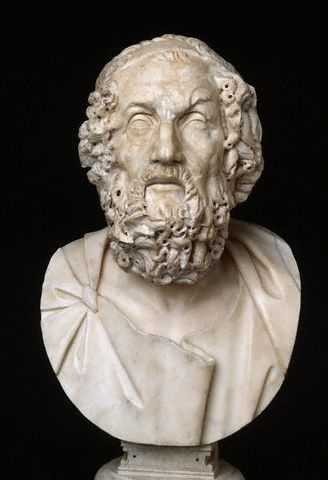 In the Odessy, Homer speaks of purple among the colors worn by his heroes;
In the Odessy, Homer speaks of purple among the colors worn by his heroes;
Iris is denominated “purple;” we have mention, also, of a “purple cloak, of a purple ball wherewith to play;” “purple coverings,” of great beauty, for beds, or seats; “purple carpets ;” “purple threads,” where the “sea- purple” is distinctly spoken of. Again, in another part of the Odyssey, we find it said, that women wove the “purple cloaks.”(1)
The Coan vest was the most prized garment and Horace says of it :
“As if unclothed she stands confessed
In a transparent Coan vest.
The 1st century Latin poet, Tibullus speaks of a Coan vest for girls :
“She may these garments wear, which female Coan hands
Have woven, and in stripes disposed the golden bands.”
A statue to the god of seasons, change and plant growth, Vertumnus had this inscription on the base :
“My nature suits each changing form,
Turned into what you please I’m fair,
Clothe me in Coan. I’m a decent lass,
Put on a toga, for a man I pass.”
While the Greeks were some of the greatest story tellers, purple silk dyers, and merchants who had ever lived, there is 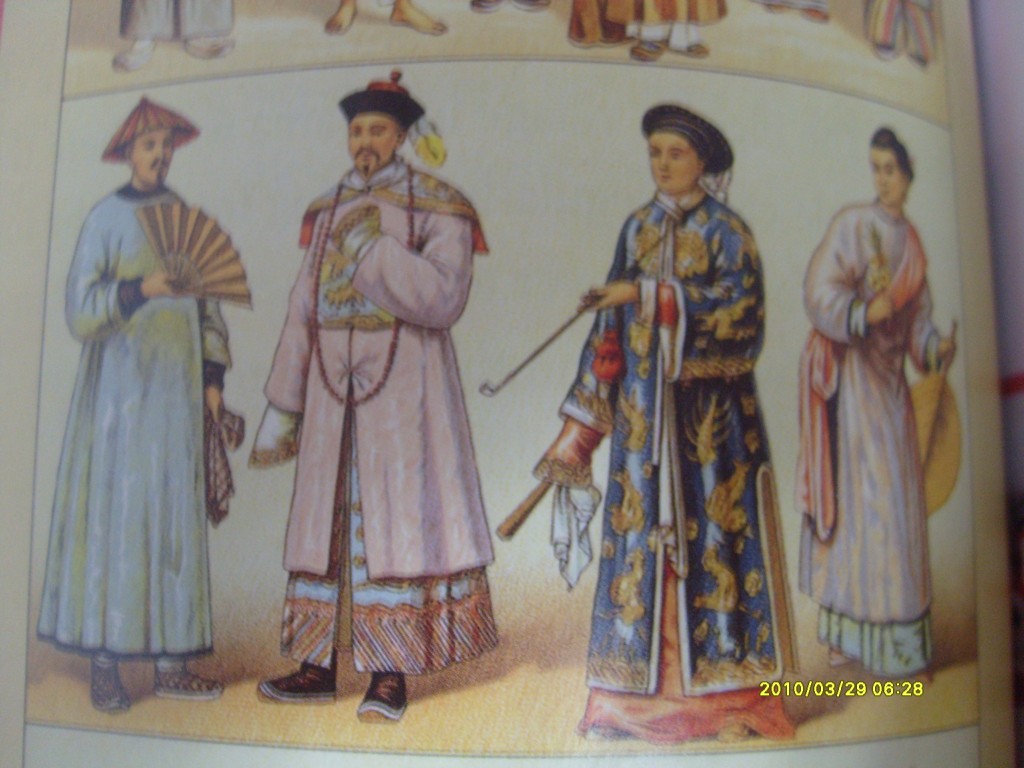 actually evidence and text supporting the fact that it was the ancient Chinese who had most likely invented silk production via the silk worm in approximately 2,700 B.C. According to Confucius, in approximately 2,640 B.C. , the Chinese princess Xi Ling Shi was the first to reel a cocoon of silk, which legend also has it, had dropped into her cup of tea. The Chinese discovered how to create valuable clothing that was not only comfortable, it was the most beautiful fabric the world had ever seen, and with the help of the silk worm over next 3,000 years, they along with the Kohens of Kos had kept their secret monopoly of silk, making them two of the richest families in the world of their time.(2)
actually evidence and text supporting the fact that it was the ancient Chinese who had most likely invented silk production via the silk worm in approximately 2,700 B.C. According to Confucius, in approximately 2,640 B.C. , the Chinese princess Xi Ling Shi was the first to reel a cocoon of silk, which legend also has it, had dropped into her cup of tea. The Chinese discovered how to create valuable clothing that was not only comfortable, it was the most beautiful fabric the world had ever seen, and with the help of the silk worm over next 3,000 years, they along with the Kohens of Kos had kept their secret monopoly of silk, making them two of the richest families in the world of their time.(2)
THE KOHENS OF KOS – THE BIRTHPLACE OF THE ROYAL PURPLE SILK MANUFACTURING
Let it be said, that it was the Asiatic Greeks, with the Kohens of Kos who would learn the silk trade from their Chinese cousins in the East and who would then take it to whole new level. 1st century historian, Pliny had said, “Colored dresses were known in the time of Homer (900 B. C.,) from which the robes of triumph were borrowed.” Throughout the Iliad, Homer often mentions the color purple, such as purple blood (xvn. 361), a purple cloud (ibid. 551), Zeus extends a purple rainbow to mortals to be a signal (Iliad, xvii), the purpling of a dark emotion in the soul (xxi. 551), purple belt buckles, and even purple meteors which were a sign of bloody war, or cold and dreary weather. Jove’s purple bow as in Genesis ix. 13, 14 where it is said, ” I will set my bow in the cloud to be a sign of a covenant between me and Earth.”
These purple accounts by Pliny and Homer are the earliest Greek accounts of silk on their shores. From then on, this production and the wearing of this specific color of silk had taken on a life of its own, lasting several centuries.(3) Horace talks about these Kohen robes in his first book, where he describes them as remarkably fine and were worn primarily by women of light character, (nymphs of the pave) that it was usually dyed purple, and sometimes enriched with stripes of gold. It is by some writers supposed to have been made of silk, because, as we learn from Aristotle, silk was at a very early period spun and woven in Cos, and was the chief cause of the high celebrity attained by the manufactures of that island.
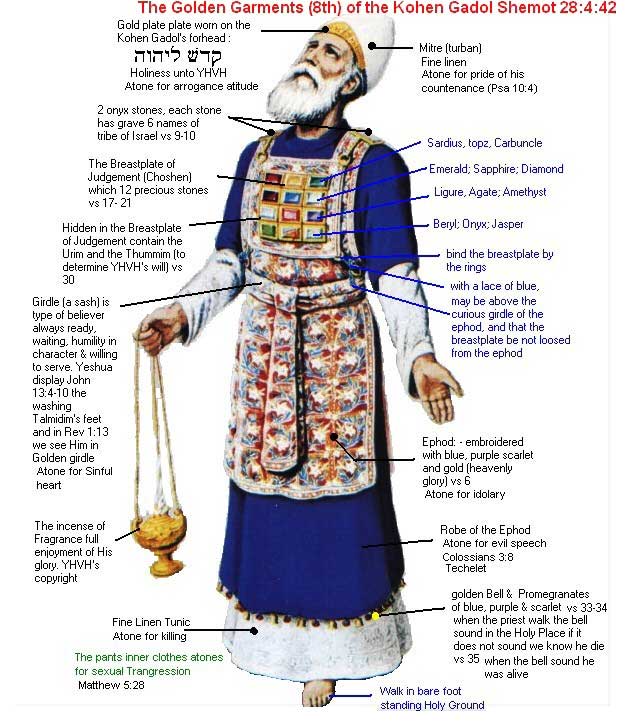 St. Luke mentions their traffic in purple dyes, in the acts of the Apostles, and St. Matthew simply calls the silk material, Scarlet. Then there is Moses, who I believe had also visited or lived on the island of Kos and/or Crete who had used stuffs of purple for the works of the costume of the high priest, and among the ornaments of the tabernacle.
St. Luke mentions their traffic in purple dyes, in the acts of the Apostles, and St. Matthew simply calls the silk material, Scarlet. Then there is Moses, who I believe had also visited or lived on the island of Kos and/or Crete who had used stuffs of purple for the works of the costume of the high priest, and among the ornaments of the tabernacle.
33 And of the blue, and purple, and scarlet, they made clothes of service, to do service in the holy place, and made the holy garments for Aaron; as the Lord commanded Moses.
34 And he made the ephod of gold, blue, and purple, and scarlet, and fine twined linen.
35 And they did beat the gold into thin plates, and cut it into wires, to work it in the blue, and in the purple, and in the scarlet, and in the fine linen; with cunning work.
36 And they made coats of fine linen of woven work for Aaron, and for his sons,
37 And a mitre of fine linen, and goodly bonnets of fine linen, and linen breeches of fine twined linen,
38 And a girdle of fine twined linen, and blue, and purple, and scarlet, of needlework; as the Lord commanded Moses.
In 1 Maccabees xliii., the Jews made a decree that only Simon should wear purple and gold, and that none of the people should wear purple or a buckle of gold without his permission. Alexander sent Jonathan a buckle of gold, as the use is to be given to such that are of the King’s blood.
These Kohens of Kos had perfected the manufacturing of silk, to the point they had cornered the market on one of the most beautiful garments, and that would result in them acquiring tremendous wealth. This world-wide demand for silk had created great prosperity for the island of Kos with their “Kohen garments and purple dye” that had remained famous up until the time of Alexander the Great, the subsequent Ptolemaic Empire, and of both Julius and Augustus Caesar who had royal purple connections with the island. During the reign of Julius Caesar and his son Augustus, from thereafter, the Roman Priesthood who were known as the Flamens Dialis had worn what was called the Lana, or what were the purple robes of the priests. Cicero had written in Latin,” Vejlitus afper nojlra bac purpura plebeia ac peat fufca.” He calls it “Our Purple,” because he was also a Member of the Roman College of Augurs. (4) The mythological founders of Rome, Romulus and Remus were augurs as well and Romulus was considered a great augur throughout the course of his life.
 Let us not forget the lover of Julius, Cleopatra, who the poet Lucan said, she had worn a piece of silk over her breast and also her magnificent purple sails which were most likely manufactured by Kohens of Kos. The connection with Kos and Cleopatra is mentioned by the 1st century Jewish-Roman Historian, Josephus in his book ” The Antiquities of the Jews ” where he had quoted Strabo, that Mithridates were sent to Kos to fetch the gold deposited there by Queen Cleopatra and “800 talents belonging to the Jews.” (“ Ant.” xiv. 7, § 2)
Let us not forget the lover of Julius, Cleopatra, who the poet Lucan said, she had worn a piece of silk over her breast and also her magnificent purple sails which were most likely manufactured by Kohens of Kos. The connection with Kos and Cleopatra is mentioned by the 1st century Jewish-Roman Historian, Josephus in his book ” The Antiquities of the Jews ” where he had quoted Strabo, that Mithridates were sent to Kos to fetch the gold deposited there by Queen Cleopatra and “800 talents belonging to the Jews.” (“ Ant.” xiv. 7, § 2)
Caligula had silk curtains to his throne and wore a silk dress when in public. Josephus had written that the Emperors Titus and Vespasian wore silk dresses after they defeated the Jews in their celebrations at Rome. During the reign of Aurelian, it was said that a pound of silk was the equivalent worth to a pound of gold, and the daughter of the consul Stilicho, Maria was discovered in a‘marble coffin in 1554, with a robe that was found to contain thirty-six pounds of gold.
The 1st century Roman poet, Horace had said this below about these glory days of the purple silk on the Island of Kos;
“Not Coan purple, nor the blaze
Of jewels, can restore the days,—To thee, those days of glory,
Which wafted on the wings of time,
Even from thy birth to beauty’s prime
The demand for this purple silk by the Romans would later cause financial troubles for their government:
The silk trade drained so much money from the Roman treasury, that Roman Emperor Tiberius complained; “ladies and their baubles are transferring our money to foreigners.” He prohibited Romans from wearing silk. In one year, Rome reportedly paid 22,000 pounds of gold for silk shipments.
SILK WAS MANUFACTURED AND CONTROLLED ON KOS AND PURPLE DYE WAS MADE ON CRETE
There is also evidence of the production of purple dye that took place 7 miles across the sea from Kos, on Crete. Here you will find the beautiful lagoon of Balos, with its white and pink sand beaches, with the most vivid blue and turquoise waters that you have ever seen. This beautiful pink sand that can be found there was actually dyed by way of millions upon millions of crushed snail shells. The very same famous sea-snails like Murex and Purpura that were used to make a reddish type dye, which would then be used in conjunction in dying the newly made silk of Kos purple.
A great description on how this purple dye was made, the various exploits and what various people would do to get, it is told quite well in the “Secrets of Animal Life,” by John Arthur Thomson;
Multitudes of snails were required in order to yield a little dye, and this meant many adventurous cruises, and these often meant many lives. So costliness embellished beauty, and the glamour of purple grew. Only a few men dare don purple robes, only a few women dare use the purple cosmetic, only the admiral’s ship or Cleopatra’s could have purple sails, only sacred script could enjoy the purple glory. Another aesthetic appeal came from pearls and mother-of-pearl, the beauty of which has never ceased to charm. To the aesthetic glamour of pearls was added the romantic touch of their mysterious origin, and it is interesting to find that a theory connecting them with dewdrops is geographically very widespread.
THE KOHENS BECOME BANKERS AND ONE OF THE MOST POWERFUL FAMILIES IN ALL THE WORLD
The Kohens had made so much money on the items they had created, such as purple silk, other inventions, medicine and ideas, that they had become some of the most powerful bankers in all the Greco-Egyptian, and later, the Roman Empire. The island of Kos may quite possibly be the birth place of true silk manufacturing, or at the very least, one of the world’s first major centers for its production. Aristotle had written, that bombykia, or the stuff produced from the oriental insect called bombykia (the silkworm), was re-spun and re-wove by the industrious women of Kos. Pliny confirms, that the bombyx was a native to the Island of Kos. This may be one of the reasons why they had developed to be such a powerful empire and priesthood.
Pliny, however, distinctly asserts, that the Coan dresses were made of silk. “The Grecian women,” he says, “unravel the silks imported from Asia, and then weave them anew, whence that fine tissue, of which frequent mention is made in the Roman poets under the name of Coan vests.” Salmasius has shown, that Pliny in this case misunderstood the passage of Aristotle’s Natural History, to which he referred. The Greek means nothing more than “females wind off the web of the silk worm, and then weave the threads,” not as Pliny would interpret it, “unravel the texture of the dress and then weave it over again.”(5 & 6)
WHAT HAPPENED TO THE ISLAND OF KOS AND THE KOHENS?
The island of Kos is now known as Dia, and is nothing but a tiny barren island located 7 miles off the coast of Crete in the Mediterranean Sea, with practically very little animal life and no humans living there. However, once upon a time, it was home to one of the largest seaports in all of Greece and the Aegean Sea. I have written two other article on the subject called, The Origins of the Kohen Priesthood and Dragon Isle: The Kohens of the Lost Island of Dia, where I explain more of the history of the island of Kos that is now called Dia and the ancient inhabitants, who were known back then, as the Koans or Koans, which in Hebrew would be Kohen or Cohen.
In addition to the ancient historical accounts of the island given above by some of the world’s most trusted historians, we also have current archaeology and research that was done in the 1970’s by one of the most famous French explorer’s of the 20th century, Jacques Cousteau who had went there on a massive underwater expedition in search of the Lost Atlantis. What he found there was nothing short of amazing. From countless shipwrecks right in the bays of the island of Dia with bounties of treasure that sat just below the surface, indicating to Cousteau and his team that the uninhabited island was at one time, one of the busiest and largest ports in all of Crete, and more than likely, one of the largest in the world at the time. I have put this video on my blog before, and I will again to show proof he did find evidence of a city and port there.
Please watch this video below at right around the 17 minute marker on, in order to witness the section of film where Cousteau visits Crete and his ultimate exploration 7 miles across the sea on the Island of Dia (Kos). This is all factual proof, that the island known today as Dia was once a huge shipping center and port with most likely great cities and temples located on the island at one time. All evidence of the Kohen priesthood from Kos. An island that has been moved and had been completely destroyed by something or someone. A lost island and people in time, until now.
The royal purple silk of the Kohen of Kos had spread to many shores around the globe over time. Even the Babylonians were known to give purple habits to their idols. After the Kohens had perfected the manufacturing and distribution methods of their silk, other silk centers had been created in various places around the world where they could easily get there by sea, such as Italy, Venice, France, Great Britain, Ireland, Central America, Mexico, China, and Japan. All these lands are also said to be inhabited in literature by the Phoenicians, who would be the Kohens and/or their cousins in which they shared their business with.
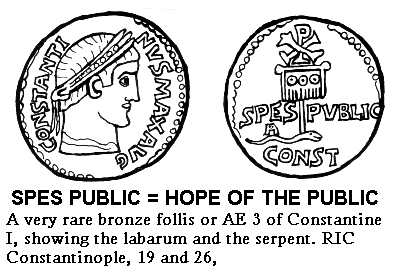 In the year 324, it was at Nicomedia that Licinius resigned his share of the imperial purple to his rival Constantine the Great, and Licinius would become a Roman emperor under Constantine from 308 to 324. From this point on, his purple royal banner was called the “Labarum of Constantine,” which was a gilt staff with a crown of gold and jewels on the top; that on the crown or within it was the monogram that displayed the “Chi-Rho” symbol ☧, formed from the first two Greek letters of the word “Christ” (Greek: ΧΡΙΣΤΟΣ, or Χριστός) — Chi (χ) and Rho (ρ), and that beneath it was attached a transverse bar, so as to form with the staff the sign of the Cross. From this bar hung a square banner-cloth of royal purple, richly adorned with gold and gems, and terminating in a fringe. Immediately below this there were attached to the staff busts of Constantine and his sons [Via Const. i. 26]. Socrates mentions this splendid banner as being preserved in the royal palace in his time.(8)
In the year 324, it was at Nicomedia that Licinius resigned his share of the imperial purple to his rival Constantine the Great, and Licinius would become a Roman emperor under Constantine from 308 to 324. From this point on, his purple royal banner was called the “Labarum of Constantine,” which was a gilt staff with a crown of gold and jewels on the top; that on the crown or within it was the monogram that displayed the “Chi-Rho” symbol ☧, formed from the first two Greek letters of the word “Christ” (Greek: ΧΡΙΣΤΟΣ, or Χριστός) — Chi (χ) and Rho (ρ), and that beneath it was attached a transverse bar, so as to form with the staff the sign of the Cross. From this bar hung a square banner-cloth of royal purple, richly adorned with gold and gems, and terminating in a fringe. Immediately below this there were attached to the staff busts of Constantine and his sons [Via Const. i. 26]. Socrates mentions this splendid banner as being preserved in the royal palace in his time.(8)
A vision which led Constantine to believe he was fighting under the protection of the Christian God who had slayed the serpent. Here is an actual image below of the real life coin of Constantine (c.337) showing a depiction of his labarum spearing the serpent.
It was Jesus who was stripped of his royal purple and then crucified at Golgotha, the place of the skull. A place, that I believe was on Crete. On the day of his execution it was said, “And they clothed him with purple, and platted a crown of thorns, and put it about his head: and began to salute him, Hail, King of the Jews. And they smote him on the head with a reed, and did spit upon him, and bowing their knees worshipped him. And when they had mocked him they took off the purple from him, and put his own clothes on him, and led him out to crucify him.”
In the story of the Virgin Mary weaving the scarlet and purple cloth for the veil of the temple; “And to Mary fell the lot of the pure purple and scarlet. And she took them and worked them in her house” – James 10:2
These purple Apocalyptic clues and silk veiled pathways seem to point to the path of one of the Kohens original homelands of Kos, now known as the island of Dia. These facts, with the massive sea port Jacques Cousteau had discovered, with real evidence of shipwrecks and bountiful treasures in the very bays of Dia, helps confirm these awesome stories of the island with its great schools, wealth and the royal purple that have been left behind for us Kohen to find the truth that has been buried in the past just like this tiny barren island of Dia. A massive purple web spun by Minerva all the way from Asia to Kos, and from there, it had become one of the most celebrated symbolic and commercial products ever spoken about in ancient literature from the Iliad to the Bible.
An interesting note, is that a new tale is being told by one of the great story tellers on the modern-day internet, that a real Kohen from Kos always finds his way home. He does not get caught in the purple web of Minerva because he knows by Gnosis how to surf the silk webs, and even find ways to make monies there, while mere mortals seem to get caught in them as they waste away spinning their own deadly cocoons.
SOURCES:
1. The art of weaving by hand and by power By Clinton G. Gilroy
2. Jeffrey Hays, “Silk Road History and Explorers,” Facts and Details
3. Romae antiquae notitia, or, The antiquities of Rome: in two parts By Basil Kennett
4. The History of Silk, Cotton, Linen, Wool, and Other Fibrous Substances By Clinton G. Gilroy
5 and 6. The Hellenes: The History of the Manners of the Ancient Greeks By James Augustus St. John
7. Transactions and Annual Report, Volume 26 By North Staffordshire Field Club
8. Dictionary of Doctrinal and Historical Theology edited by John Henry Blunt
9. Other sources are listed and or linked to in yellow and they can also easily be found via open source on Google. Hence, do your own research if you want to verify or discredit my words.

Moe is the founder of GnosticWarrior.com. He is a father, husband, author, martial arts black belt, and an expert in Gnosticism, the occult, and esotericism.

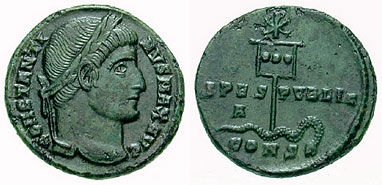




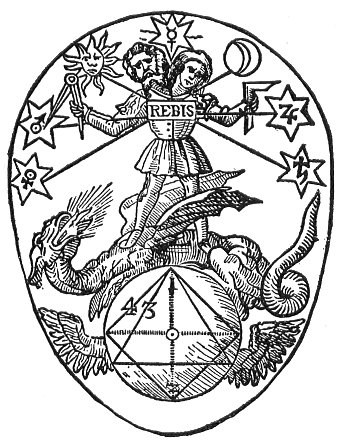

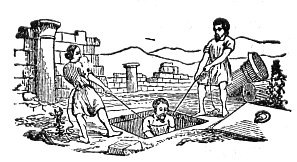
Just goes to show even dating back then was the oldest profession of choice, LOL!
Lets just hope it gets better now.